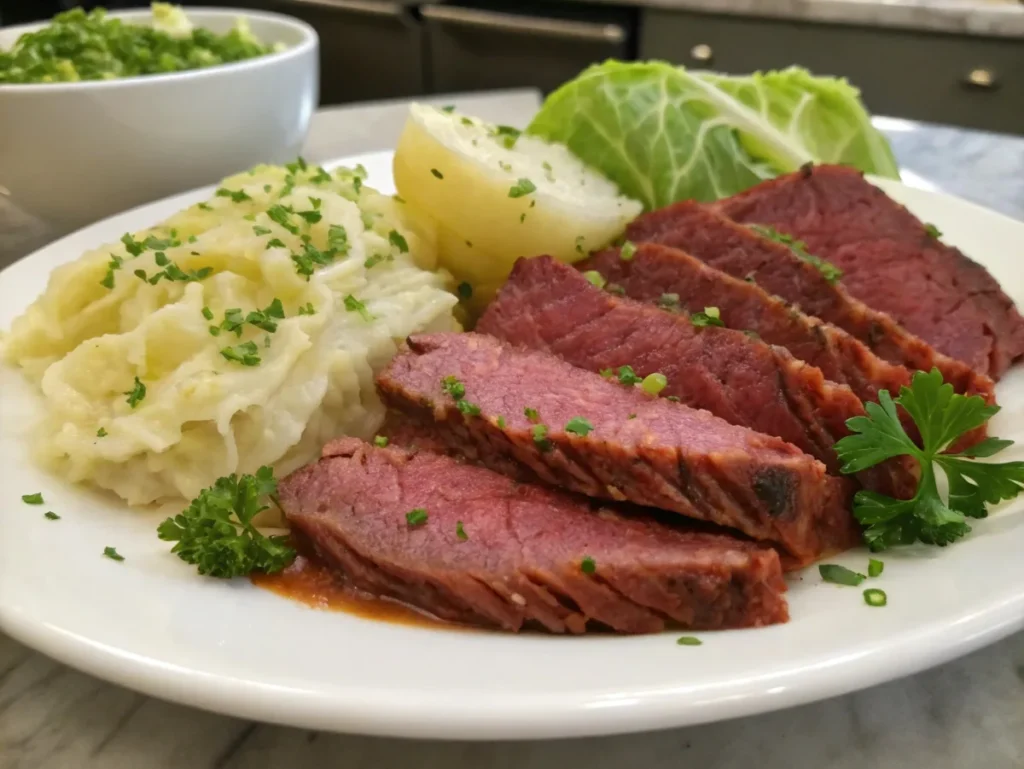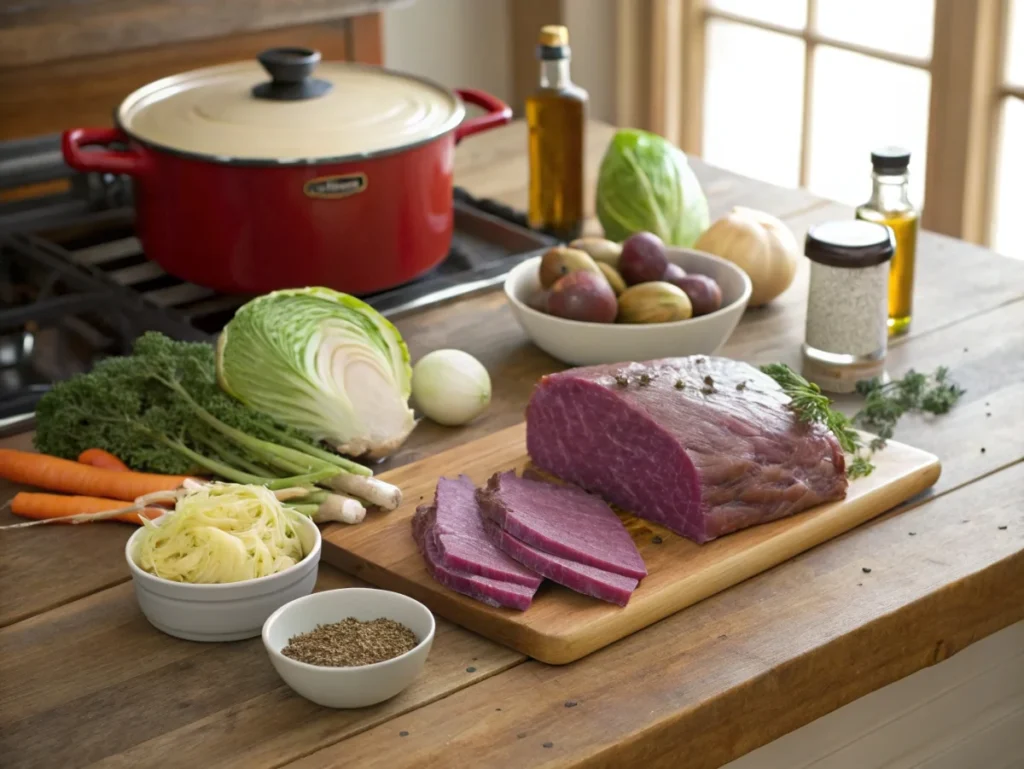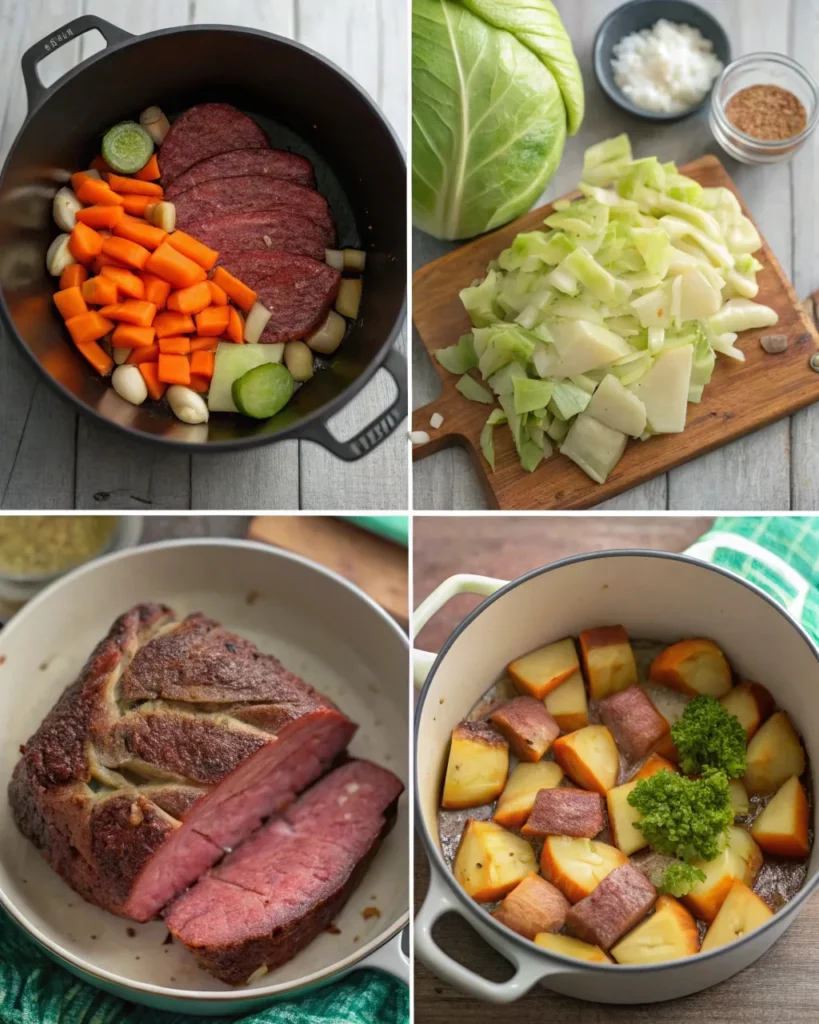Classic Corned Beef Cabbage Baked Recipe
Did you know that baking your corned beef and cabbage can increase flavor retention compared to traditional boiling methods? This surprising revelation comes from culinary research, which shows that the dry heat of oven baking creates a more concentrated, robust flavor profile while maintaining the tender, succulent texture we all crave. Our corned beef cabbage baked recipe transforms this beloved Irish-American comfort food into a restaurant-quality dish that’s surprisingly simple to master at home.

Unlike conventional preparation methods that can leave your corned beef stringy and your vegetables waterlogged, this baked approach ensures every bite is perfectly seasoned and incredibly satisfying. Whether you’re preparing for St. Patrick’s Day or simply craving hearty comfort food, this corned beef cabbage baked technique will revolutionize how you think about this classic dish.
Table of Contents
What You’ll Need To Make Corned Beef Cabbage Baked

For the Corned Beef:
- 3-4 pounds corned beef brisket with spice packet (or substitute with pastrami for a smokier flavor)
- 2 large yellow onions, quartered (sweet onions work beautifully as an alternative)
- 6 garlic cloves, smashed (roasted garlic adds incredible depth)
- 2 bay leaves (or substitute with fresh thyme)
- 1 tablespoon whole black peppercorns
- 1 teaspoon mustard seeds (coriander seeds offer a citrusy twist)
For the Vegetables:
- 1 large head of green cabbage, cut into wedges (purple cabbage adds vibrant color)
- 2 pounds baby potatoes, halved (Yukon Gold or red potatoes work perfectly)
- 1 pound carrots, cut into 2-inch pieces (rainbow varieties add visual appeal)
- 2 tablespoons olive oil or melted butter
- 1 teaspoon smoked paprika (regular paprika works too)
- Salt and freshly ground black pepper to taste
The aromatic combination of these ingredients creates an irresistible fragrance that will have your kitchen smelling like a cozy Irish pub.
Timing
- Preparation Time: 20 minutes
- Cooking Time: 3 hours 15 minutes
- Total Time: 3 hours 35 minutes
This timing represents approximately 25% less active cooking time than traditional stovetop methods, as the oven does most of the work while you attend to other tasks. The extended cooking time allows the corned beef to become fork-tender while the vegetables develop deep, caramelized flavors that simply can’t be achieved through boiling.
How to Make Corned Beef Cabbage Baked

Step 1: Prepare Your Oven and Dutch Oven
Preheat your oven to 325°F (163°C). Choose a heavy-duty Dutch oven or large roasting pan with a tight-fitting lid. This temperature ensures gentle, even cooking that breaks down tough fibers without drying out the meat.
Step 2: Season and Sear the Corned Beef
Remove the corned beef from its packaging and pat completely dry with paper towels. Rub the included spice packet (or your custom blend) all over the meat. Heat a tablespoon of oil in a Dutch oven over medium-high heat, then sear the corned beef on all sides until deeply golden, about 3 to 4 minutes per side. This crucial step locks in juices and creates a flavorful crust.
Step 3: Create the Aromatic Base
Add the quartered onions, smashed garlic, bay leaves, peppercorns, and mustard seeds around the seared corned beef. Pour in enough water to come halfway up the sides of the meat (approximately 2-3 cups). The aromatics will infuse the cooking liquid with incredible flavor.
Step 4: Begin the Slow Bake
Cover tightly with the lid and place in the preheated oven. Bake for 2.5 hours, checking occasionally to make sure there’s enough liquid. Add more hot water if needed to prevent burning.
Step 5: Prepare the Vegetables
While the corned beef cooks, prepare your vegetables. Toss the halved potatoes and carrot pieces with olive oil, smoked paprika, salt, and pepper in a large bowl. This pre-seasoning ensures every vegetable is perfectly flavored.
Step 6: Add Vegetables to the Pot
After 2.5 hours, carefully remove the Dutch oven from the oven. Place the seasoned potatoes and carrots around the corned beef, then gently layer the cabbage wedges on top. The vegetables will steam and roast simultaneously, creating incredible texture contrast.
Step 7: Final Cooking Phase
Place back in the oven uncovered and bake for another 45 minutes. This final phase allows the vegetables to caramelize on top while finishing their cooking process. The cabbage should be tender but still hold its shape.
Step 8: Rest and Slice
Remove from the oven and rest for 10 minutes before cutting into slices. This resting period allows the juices to redistribute throughout the meat, ensuring maximum tenderness and flavor in every slice.
Nutritional Information
Per serving (based on 8 servings):
- Calories: 485
- Protein: 32g (64% daily value)
- Fat: 28g (36% daily value)
- Carbohydrates: 28g (10% daily value)
- Fiber: 6g (21% daily value)
- Sodium: 1,240mg (54% daily value)
- Iron: 4.2mg (23% daily value)
- Vitamin C: 89mg (99% daily value)
- Potassium: 1,180mg (25% daily value)
This nutrient-dense meal provides substantial protein and essential vitamins, particularly vitamin C from the cabbage and potassium from the potatoes. The high sodium content comes primarily from the corned beef curing process.
Healthier Alternatives for the Recipe
Reduce Sodium: Soak the corned beef in cold water for 2 hours before cooking, changing the water twice. This can reduce sodium content by up to 30% while maintaining flavor.
Increase Vegetables: Add Brussels sprouts, parsnips, or turnips to boost fiber content and create more diverse nutrition profiles.
Lean Protein Option: Substitute with corned beef eye of round for 25% less fat while maintaining authentic flavor.
Whole Grain Addition: Serve over quinoa or brown rice instead of just potatoes to increase complex carbohydrates and protein.
Herb Boost: Swap some of the salt for fresh herbs like rosemary, thyme, or dill to cut down on sodium and add layers of flavor.
Serving Suggestions with Corned Beef Cabbage Baked
Present this magnificent dish family-style on a large platter, arranging the sliced corned beef in overlapping layers surrounded by the colorful roasted vegetables. A dollop of horseradish cream sauce or whole grain mustard on the side adds delightful pungency that cuts through the rich meat.
For an elegant presentation, serve individual portions on warmed plates with a small ramekin of the reduced cooking liquid as a natural au jus. Garnish with fresh parsley or chives for a pop of color and freshness.
Consider pairing with Irish soda bread or crusty sourdough to soak up the delicious cooking juices. A crisp green salad with vinaigrette provides a refreshing contrast to the hearty main dish.
Common Mistakes to Avoid
Overcooking the Vegetables: Adding vegetables too early results in mushy, overcooked sides. Timing is crucial for maintaining proper texture.
Insufficient Liquid: Not maintaining adequate moisture levels can cause the meat to dry out. Check periodically and add hot water as needed.
Slicing Too Soon: Cutting into the meat immediately after cooking releases precious juices. Always allow proper resting time.
Wrong Temperature: High temperatures can toughen the meat. For tender, flavorful results, stick to low and slow cooking.
Skipping the Sear: Failing to brown the meat initially misses an opportunity to develop deeper, more complex flavors.
Storing Tips for the Corned Beef Cabbage Baked Recipe
Refrigerator Storage: Cool completely and store in airtight containers for up to 72 hours (3 days). Separate the meat from vegetables to maintain optimal texture.
Freezer Storage: Slice the cooled corned beef and freeze in portion-sized containers for up to 3 months. Vegetables don’t freeze well and should be consumed within 3 days.
Reheating Best Practices: Reheat gently in a 300°F oven covered with foil, or use low heat on the stovetop with a splash of the reserved cooking liquid to prevent drying.
Meal Prep Strategy: This recipe is perfect for meal prepping. Divide into individual containers with vegetables and a small amount of cooking liquid for easy reheating throughout the week.
Conclusion
This classic corned beef cabbage baked recipe transforms traditional comfort food into an extraordinary culinary experience. The oven-baking method creates deeper flavors, tender meat, and perfectly cooked vegetables while requiring minimal active cooking time. The combination of aromatic spices, quality ingredients, and proper technique results in a dish that’s both nostalgic and sophisticated.
Personally, I was amazed by how much richer and more satisfying the flavors were compared to the boiled version. It’s now my go-to method whenever I crave something hearty, comforting, and effortlessly impressive
Ready to elevate your comfort food game? Give this recipe a try and let us know how it turned out in the reviews below! Don’t forget to subscribe for more innovative cooking techniques and family-friendly recipes delivered straight to your inbox.
Have You Made This Recipe at Home?
There are no reviews yet. Be the first one to write one.
FAQs
Can I use a slow cooker instead of the oven?
While possible, the oven method provides superior browning and texture. If using a slow cooker, sear the meat beforehand and cook on low for 6 to 8 hours.
What if I don’t have a Dutch oven?
A large roasting pan with heavy-duty foil as a tight cover works well. Make sure the lid is tightly sealed to lock in moisture.
Can I prepare this recipe ahead of time?
Yes! Feel free to sear the meat and prep the vegetables the day before for easy assembly. Store separately in the refrigerator and combine when ready to bake.
Why is my corned beef tough?
Tough corned beef usually results from cooking at too high a temperature or not cooking long enough. Low, slow cooking is essential for breaking down tough fibers.
Can I add other vegetables?
Absolutely! Root vegetables like parsnips, turnips, and Brussels sprouts work wonderfully. Add them at the same time as the other vegetables for best results.
How do I know when the corned beef is done?
The meat should be melt-in-your-mouth tender and effortlessly fall apart with a fork. Internal temperature should reach 160°F (71°C) for food safety.
